The Proxima Vara Story
By Mark Simonson
PROXIMA VARA is the variable version of Proxima Nova. It’s a typeface idea I’ve been working on in various forms since 1981. It was no more than rough sketches back then, but the concept for the lowercase was quite similar to how it eventually turned out. ♦ In 1991, I was art director at a magazine where I was using Gill Sans. I liked it, but wished for something a bit plainer and more modern that still had a geometric feel. Such a face did not seem to exist. Starting from my 1981 idea, I began working on a new typeface to fill this need. ▶ I wanted the general proportions and stroke contrast of Helvetica or Akzidenz Grotesk, but with construction and details borrowed variously from Futura, Kabel, the ATF gothics (Copperplate Gothic, News Gothic, Franklin Gothic, etc.) and the U.S. Federal Highway signage typeface. ♦ The result was a hybrid; a face combining modern, even-width proportions with a somewhat geometric appearance. ★ I released it in 1994 as Proxima Sans, with three weights—Regular, Medium, and Black and matching italics. ● I had plans to do more weights, small caps, a condensed version, and other ideas. But between lackluster sales, becoming a new parent, and taking on a new full-time job, I found I didn’t have the time or energy to continue working on it for a while. ▶ In the early 2000s, I started to get requests to expand the Proxima Sans family and Rolling Stone magazine chose it as part of its redesign in 2002. Encouraged by all this, I resumed work on it. ♦ In 2005, I re-released it as Proxima Nova, a family of 42 fonts—seven weights and three widths with matching italics. Built from the start with OpenType in mind, it featured advanced typographic features like small caps, different figure styles, and alternate characters. ● Proxima Nova was a major upgrade over the original. I reviewed and refined every character and rebuilt everything from scratch. The character set grew from 245 to 699 characters. ▶ Since I first released Proxima Nova, I’ve continued to make improvements and enhancements, such as additional language support, including Vietnamese, Cyrillic and Greek (bringing the character count to 1432), and have added a new weight—Medium—for a total of 48 styles. ★ Proxima Vara continues this evolution, adding OpenType Font Variations (OTVar). This puts all the styles and features of Proxima Nova into a single font file. All the original styles exist as named styles which you can select from font menus. But in apps and web browsers that support variable fonts, you can select any arbitrary weight, width, or slant using sliders or specifying values, giving Proxima Vara 5,000,000 possible styles.
N.B.: This text is editable. Try it!

